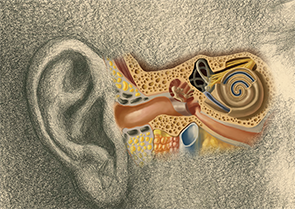
Image Credit: Spencer Sutton / Science Source
Konstantina Stankovic, MD, PhD, associate professor of otology and laryngology at Harvard Medical School and associate surgeon at the Massachusetts Eye and Ear Infirmary, finds it astounding that we don’t know more about what happens inside the inner ear.
Explore This Issue
December 2015Globally, hearing loss is the most common sensory loss, with 600 million people affected worldwide. And it is the most common congenital anomaly, with one in 500 newborns affected. Most sensorineural hearing loss starts in the inner ear.
“Given the magnitude of the problem, it’s mind-boggling that today, in the 21st century, we cannot biopsy the inner ear and we cannot see cells inside it to establish diagnosis,” said Dr. Stankovic, delivering the Howard P. House, MD Memorial Lecture for Advances in Otology during the Annual Meeting of the American Academy of Otolaryngology-Head and Neck Surgery, held in September in Dallas. She and colleagues at her laboratory are working to demonstrate what is possible when neuroscience and biotechnology are used imaginatively to tackle real-world clinical problems.
Advances from her lab include a new use of optical tools to better assess the condition of the inner ear to help with diagnosis and treatment, development of a completely implantable cochlear implant, the use of electric potential in the inner ear to power very small devices, a deeper understanding of vestibular schwannoma’s effects on hearing loss and potential treatments, and an understanding of the role of osteoprotegerin in the inner ear, which may have implications for hearing loss therapy.
Despite the inner ear being located deep in the base of the skull and very tiny, Dr. Stankovic and her colleagues have made it a mission to overcome this and other hurdles in order to expand research and advances in the inner ear.
New Imaging of the Inner Ear
Some research on mice using optical imaging based on laser light has found damage to hair cells after exposure to a sound at the volume of a snowblower. Dr. Stankovic and her colleagues are developing an endoscope that can be used to establish what is happening in the inner ear in any given patient.
“This strongly motivates the need to develop tools that would allow us to see inside the ear and establish cellular-level diagnosis,” she said. “The workhorse of hearing testing today, an audiogram, is notoriously insensitive.” She envisions a tool that could be wheeled around and used during outpatient procedures and would “literally take a few minutes” to image through the inner ear canal to give a picture of what’s going on. “This could be important not only to establish diagnosis but to guide therapy.”
Fully Implantable Cochlear Implant
Dr. Stankovic has also developed a prototype for a fully implantable cochlear implant, which would help overcome limitations of current versions that have external and internal components. With the prototype, the pattern of speech input matched the pattern of the speech output.